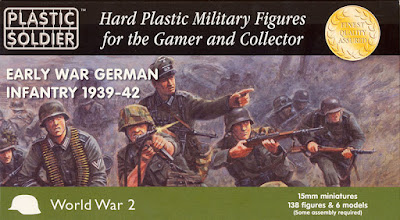 |
| Sherman II at El Alamein, by Steven Zaloga |
To date, I've been concentrating my WWII Western Desert modelling on the early period, up to 1941 and Operation Crusader. Now I'm extending that out a bit towards the era of Operation Lightfoot and the battles of El Alamein.
To that end, I thought I might want some Shermans, and the one I like the best is the M4A1, known to the Brits as the Sherman II. I like it because its cast hull is so rounded and cuddly.
Zachary Kavulich has already designed a model of the M4A1, so that's where I started.
I reattached the tracks to the hull (Zac has them as separate objects) and filled in the voids under the sand shields. There were some very thin walls on the sand shields that I knew from experience would cause me issues in printing.
I initially printed it sitting horizontally on its tracks, and sliced it sunk down into the bed by about 0.3mm to get a smooth face along the bottom run of the tracks for best adhesion on the print bed.
The results were OK, but the characteristic fluting on the bogies was lost — I'm using a 0.4mm nozzle, too large to render vertical details that small. I could probably suggest the detail with paint, but I thought I could probably get it to print if I went about it another way.
The next version's hull was split up fore and aft (see below) and printed standing vertically.
This gave me very good results on the upper hull, but resulted in multiple issue in the running gear. Unsupported wheels partially failed, and the grooves of the track detail created very weak strips that also failed.
So, more modifications.
I flattened out the underneath of the tracks to remove the weak indentations, and took the opportunity to add some track guides and studs to provide a bit more track detail to look at.
That fixed the issues with the tracks themselves, but there are still problems with wheel failures which I will need to address, All in all though, it's come together fairly successfully.
Chopping It Up
I use 3d Builder, which comes bundled with Windows 10, for this task.
The
Split utility is found under the Edit menu, and is pretty intuitive to use. You can move and rotate the split plane manually, or enter precise values in the dialogue at the bottom of the screen.
Just remember to enable
Keep Both or else when you confirm the split, it will delete one half or the other.
While the two halves are still in place, but separated, I added a couple of location holes, 2mm in diameter by 6mm deep.
I can use short lengths of 1.75mm filament in these holes to ensure accurate placement of the two halves when I come to glue them together.
Then I rotate each half so that it's standing up on the split plane, and go to
Object > Settle to make sure they're both sitting flat on the print bed, and at the same level.
Then, last of all
Save As... to a new filename. 3d Builder defaults to its own file format, .3dm, which is much better than .stl. Cura will open .3dm files, but they usually have to then be manually placed on the print bed, so purely out of laziness I usually save to .stl format in spite of the shortcomings of the file type.
This is how the new STL looks once it's in Cura for slicing.
And this is how it looks fresh off the printer.
Almost all that stringing is from support to support, rather than attached to the model itself, so there's very little cleanup necessary once the supports have been removed.
Incidentally, this is how I deal with the turrets of all my tanks and things for wargaming.
I glue a 6mm x 1mm rare earth magnet in the bottom of the turret plug, and a nail head in the floor of the turret hole in the hull. This allows the turret to rotate freely, while still being held securely. The magnet is strong enough that the whole model can be lifted by the turret, if need be.
I model sockets to accommodate the magnet and nail head in all my models. The socket in the hull has a central hole that goes right through, allowing the end of the nail head to just peep out for gluing.
I ensure that they're located accurately with respect to each other by first gluing the magnet in place, then sticking the nail head to that, and lowering the whole lot together into place in the turret socket. Then I push epoxy glue down into the hole through the hull from below, so that it grabs the shaft of the nail head without getting all over the turret plug itself.
And more...
 |
| Redesigned turret with hatch open |
 |
| ...and including a commander |
I went a bit further and remixed Zac Kuvalich's turret to open the commander's hatch, and I added a bit of seam detail to the turret box as well.
I've printed a few of these, and it works just fine. I'll probably use some PSC tank commanders in them, or whatever I can find in my bits box.
I also designed a separate commander figure (right) but my FDM printer is unlikely to render any of that detail very well. It'll be nice to have around if I ever get a resin printer though.























































